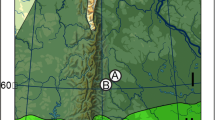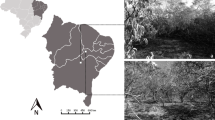Abstract
In the present study we analyzed prey preferences of the polyclad flatworm Prostheceraeus roseus among three different species of colonial ascidians of the genus Pycnoclavella occurring sympatrically in the Northwestern Mediterranean (Spain). Palatability assays were conducted in laboratory conditions in order to test predator preferences in pairwise tests, and cycles of abundance of the predator and prey were monitored in the field. The results showed a clear preference of the predator for Pycnoclavella communis over Pycnoclavella nana and Pycnoclavella aurilucens. We suggest that chemical variation in defense compounds among species of this secondary metabolite-rich genus can drive the flatworm preferences. The ascidian had seasonal cycles in the area studied, with resting (aestivation) states in the summer months. The flatworm abundance showed no clear seasonal cycle, but it was less abundant in winter. The predator has been seen in the field feeding either on active zooids or on the reserve-laden basal mass of tunic during the aestivation phase of P. communis.


Similar content being viewed by others
References
Appleton, D. R. & B. R. Copp, 2003. Kottamide E, the first example of a natural product bearing the amino acid 4-amino-1, 2-dithiolane-4-carboxylic acid (Adt). Tetrahedron Letters 44: 8963–8965.
Appleton, D. R., M. J. Page, G. Lambert, M. V. Berridge & B. R. Copp, 2002. Kottamides A–D: novel bioactive imidazolone-containing alkaloids from the New Zealand ascidian Pycnoclavella kottae. Journal of Organic Chemistry 67: 5402–5404.
De Caralt, S., S. López-Legentil, I. Tarjuelo, M. J. Uriz & X. Turon, 2002. Contrasting biological traits of Clavelina lepadiformis (Ascidiacea) populations from inside and outside harbours in the western Mediterranean. Marine Ecology Progress Series 244: 125–137.
Erpenbeck, D. & R. M. M. Van Soest, 2007. Status and perspective of sponge chemosystematics. Marine Biotechnology 9: 2–19.
Kubanek, J., D. E. Williams, E. Dilip de Silva, T. Allen & R. J. Andersen, 1995. Cytotoxic alkaloids from the flatworm Prostheceraeus villatus and its tunicate prey Clavelina lepadiformis. Tetrahedron Letters 36: 6189–6192.
Lafargue, F., A. A. Ramos, X. Turon, B. Banaigs & M. Wahl, 1986. The littoral ascidians of the Spanish Mediterranean I. From Port Bou to the Islas Medas. Vie et Milieu 36: 133–139.
López-Legentil, S. & X. Turon, 2005. How do morphotypes and chemotypes relate to genotypes? The colonial ascidian Cystodytes (Polycitoridae). Zoologica Scripta 34: 3–14.
Loukaci, A., G. Muricy, J. P. Brouard, M. Guyot, J. Vacelet & N. Boury-Esnault, 2004. Chemical divergence between two sibling species of Oscarella (Porifera) from the Mediterranean Sea. Biochemical Systematics and Ecology 32: 893–899.
Novell, C., 2001. Contribution to the knowledge of polyclad Turbellaria of the Catalan coast. PhD Thesis, University of Barcelona, Spain. Available at: http://www.tesisenxarxa.net/TESIS_UB/AVAILABLE/TDX-0107104-121621//Tesis.PDF.
Paul, V. J., E. Cruz-Rivera & R. W. Thacker, 2001. Chemical mediation of macroalgal-herbivore interactions: ecological and evolutionary perspectives. In McClintock, J. B. & B. J. Baker (eds), Marine Chemical Ecology. CRC Press, Boca Raton, 227–265.
Pérez-Portela, R., S. Duran, C. Palacín & X. Turon, 2007. The genus Pycnoclavella (Ascidiacea) in the Atlanto-Mediterranean region: a combined molecular and morphological approach. Invertebrate Systematics 21: 187–205.
Pisut, D. P. & J. R. Pawlik, 2002. Anti-predatory chemical defenses of ascidians: secondary metabolites or inorganic acids? Journal of Experimental Marine Biology and Ecology 270: 203–214.
Ramos, A. A., X. Turon, M. Wahl, B. Banaigs & F. Lafargue, 1999. The littoral ascidians of the Spanish Mediterranean. II. Balearic Islands. Vie et Milieu 41: 153–163.
Schupp, P., C. Eder, P. Proksch, V. Wray, B. Schneider, M. Herderich & V. J. Paul, 1999. Staurosporine derivatives from the ascidian Eudistoma toealensis and its predatory flatworm Pseudoceros sp. Journal of Natural Products 62: 959–962.
Stachowicz, J. J., 2001. Chemical ecology of mobile benthic invertebrates: predators and prey, allies and competitors. In McClintock, J. B. & B. J. Baker (eds), Marine Chemical Ecology. CRC Press, Boca Raton, 157–194.
Stoecker, D., 1980a. Chemical defenses of ascidians against predators. Ecology 61: 1327–1334.
Stoecker, D., 1980b. Relationships between chemical defense and ecology in benthic ascidians. Marine Ecology Progress Series 3: 257–265.
Tarjuelo, I., S. López-Legentil, M. Codina & X. Turon, 2002. Defense mechanisms of adults and larvae of colonial ascidians: patterns of palatability and toxicity. Marine Ecology Progress Series 235: 103–115.
Turon, X., 1988. The ascidians of Tossa de Mar (NE Spain). II. Biological cycles of the colonial species. Cahiers de Biologie Marine 29: 407–418.
Acknowledgements
We thank A. Riesgo for the colonies of Pycnoclavella spp. collected for palatability assays. Dr. C. Novell helped with flatworm identification. A. El Nagar made interesting comments on the manuscript. The research was funded by project CTM2004-05265–C02-01 of the Spanish Government.
Author information
Authors and Affiliations
Corresponding author
Additional information
Handling editor: I. Nagelkerken
Rights and permissions
About this article
Cite this article
Pérez-Portela, R., Turon, X. Prey preferences of the polyclad flatworm Prostheceraeus roseus among Mediterranean species of the ascidian genus Pycnoclavella . Hydrobiologia 592, 535–539 (2007). https://doi.org/10.1007/s10750-007-0807-2
Received:
Revised:
Accepted:
Published:
Issue Date:
DOI: https://doi.org/10.1007/s10750-007-0807-2




